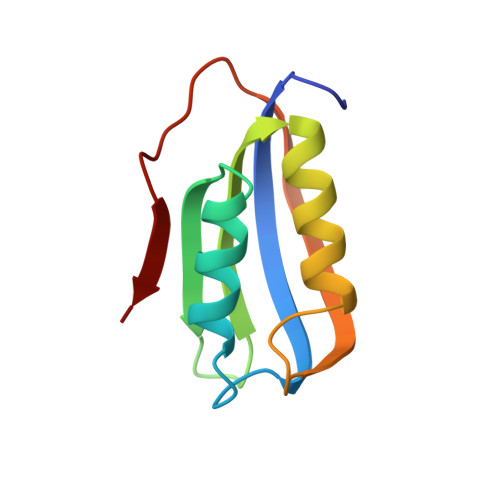Crystal structure of common type acylphosphatase from bovine testis.
Thunnissen, M.M., Taddei, N., Liguri, G., Ramponi, G., Nordlund, P.(1997) Structure 5: 69-79
- PubMed: 9016712
- DOI: https://doi.org/10.1016/s0969-2126(97)00167-6
- Primary Citation of Related Structures:
2ACY - PubMed Abstract:
Acylphosphatase (ACP) is a low molecular weight phosphomonohydrolase catalyzing with high specificity the hydrolysis of the carboxyl-phosphate bond present in acylphosphates. The enzyme is thought to regulate metabolic processes in which acylphosphates are involved, such as glycolysis and the production of ribonucleotides. Furthermore the enzyme is capable of hydrolyzing the phospho-aspartyl intermediate formed during the action of membrane pumps such as (Ca2++Mg2+) ATPase. Although the tertiary structure of a muscle ACP has been determined by NMR spectroscopy, little is known about the catalytic mechanism of ACP and further structures might provide an increased understanding. The structure of 'common type' ACP from bovine testis has been determined by X-ray crystallography to a resolution of 1.8 A. The structure has been refined to an R factor of 17.0 % using all data between 15 and 1.8 A. The binding of a sulphate and a chloride ion in the active centre allows a detailed description of this site. The overall protein folds of common type and muscle ACP are similar but their loops have very different conformations. These differences, in part, are probably caused by the binding of the ions in the active site of the common type form. The phosphate-binding loop of ACP shows some remarkable similarities to that of low molecular weight protein tyrosine phosphatase. The active site of ACP has been located, enabling a reaction mechanism to be suggested in which the phosphate moiety bound to Arg23 acts as a base, abstracting a proton from a nucleophilic water molecule liganded to Asn41. The transition-state intermediate is stabilized by the phosphate-binding loop. We suggest the catalysis to be substrate assisted, which probably explains why this enzyme can only hydrolyze acylphosphates.
- Department of Molecular Biology, University of Stockholm, S-106 91, Stockholm, Sweden.
Organizational Affiliation:


















